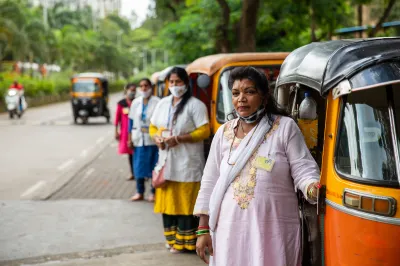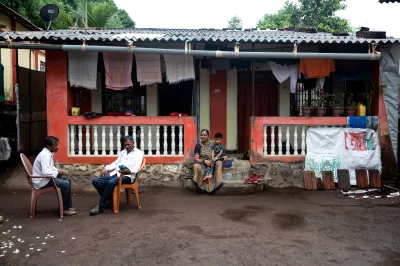What Most Providers Don’t Realize About Microentrepreneurs
Financial services providers often have difficulty assessing the creditworthiness of very small businesses that mostly transact using cash or informal financial services. On a recent visit to Bangalore, India, CGAP worked with Janalakshmi Financial Services to deepen our understanding of microentrepreneurs through research and qualitative discussions. We found that the conventional measures used to assess larger businesses, such as formal credit history, the size of an enterprise and the number of years it has been in business, often incompletely assess the business acumen of microentrepreneurs, casting them as a volatile, transitory and hard-to-reach group.

The story of Janaki, one of the customers we met, illustrates why looking at this segment through a different lens can help providers to better understand microentrepreneurs and develop services that meet their needs.
Janaki owns a tiny restaurant on a busy street in Bangalore’s Kamanahalli neighborhood. She cooks and runs the business on her own, serving lunch to customers who work nearby in the services and retail industries. She has been in business for 15 years, but providers that rely on conventional measures of creditworthiness often miss this fact. As a microentrepreneur with little support and no permanent employees, Janaki had to close her shop for a while to take care of a work-related injury. This lapse, though brief, causes providers to assess her as a “new venture” and overlook her experience. This counts against her when she applies for loans.
Conventional measures also lead providers to determine that Janaki lacks a robust business strategy. After all, providing lunch out of a small room seems simple compared to the work of enterprises that manage sprawling supply chains and inventories. But a closer look reveals that she has what could be called “microstrategies" that have helped her to become a resilient entrepreneur. For example, one might assume that Janaki dishes out lunch on a first-come-first-serve basis until she runs out of food each day. Instead, she says, she turns away walk-ins if she is running low to save food for her regular clients. This earns their loyalty.
Another example of Janaki's strategic thinking is how she deals with food waste — a common challenge for small eateries that do not have air conditioning. Over time, she has learned how to estimate her daily supply need, create recipes to minimize waste and juggle short-term uncertainty with long-term customer-base-building to manage her revenues. To some, these decisions may seem inconsequential, but they are well-honed microstrategies that have served her well for years.
Finally, providers tend to analyze businesses based on transactions. In doing so, they may overlook the fact that many microentrepreneurs view their businesses in terms of local relationships that can be cultivated to manage cash flow gaps. Microentrepreneurs often build hyperlocal networks that help them deal with uncertainty, manage tight cash flow cycles and become more resilient. Janaki relies on a local network for both a regular flow of clients and reliable suppliers. For example, lack of refrigeration and storage space means that she must maintain a tight inventory of perishables and nonperishables. She also runs on a tight cash flow, starting the morning without enough cash on hand to buy the day’s supplies and ending with cash. She gets help managing her cash flow and supply from local suppliers with whom she has built relationships over time — relationships marked by reciprocity, flexibility, credit and trust. They advance her the supplies each morning and let her pay at the end of the day, or even a few days later, if the need arises. Likewise, if a supplier is running short and asks for an expedited payment, Janaki tries her best to pay upfront. This flexible, mutually respectful relationship is highly valued because all parties are juggling tight resources with each other’s help.
Janaki's story reminds us that although characteristics like formal credit history and years in business play a role in assessing microentrepreneurs, they can tell an incomplete and possibly misleading story. To get a more complete picture, it is important to understand whether microentrepreneurs have strong networks and effective microstrategies in place to help them succeed (informal moneylenders have been assessing these factors for years). Providers should try to become part of microentrepreneurs' local networks rather than try to replace them. This does not need to be complex or expensive. It just requires tweaking how they assess and serve microentrepreneurs based on a better understanding of their behaviors and needs.




Comments
It's such a revelation to
It's such a revelation to read about her microstratagies , consistency and her dependability - there ought to be metrics for her to be assessed inline with her creditworthiness .
Micro insurance need to be
Micro insurance need to be integrated to protect from the loss impacted by work related injury /accident /illness in these kind of microentreprenuers run by Janaki
I completely agree with the
I completely agree with the post. My experience of visiting micro-entrepreneurs in Ghana for the past 5 years tells me exactly the same. You need to adapt traditional economics analysis in order to understand them. I say "adapt" and not "change" on purpose. Janaki's has a "strategic plan" as any other business. It is just not formally documented, but it serves the same purpose.
Thank you for your comment,
Thank you for your comment, Marco. I agree that we need to adapt our analysis to incorporate these realities, skills and strategies.
yes absolutely agree!
yes absolutely agree!
Add new comment